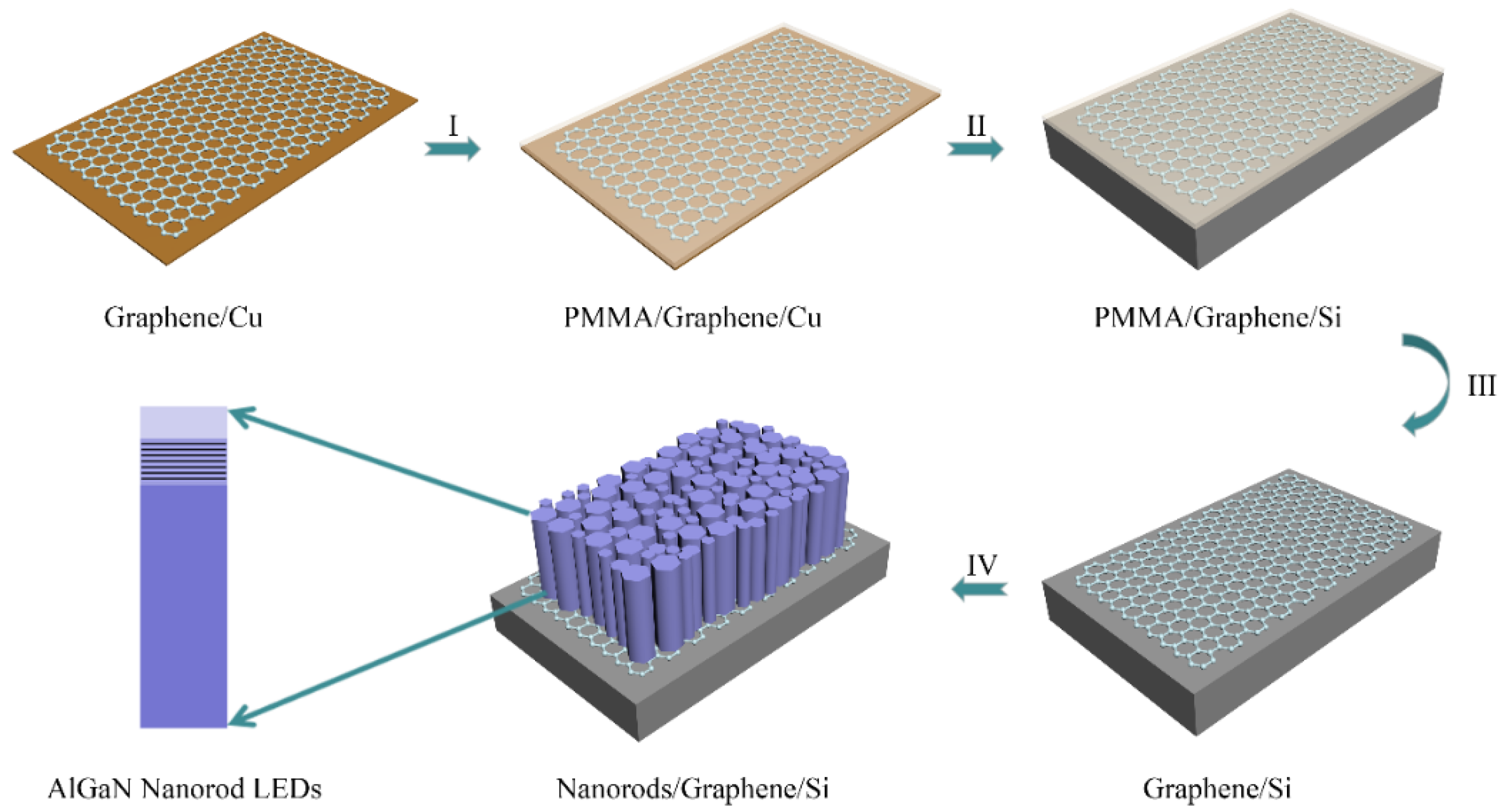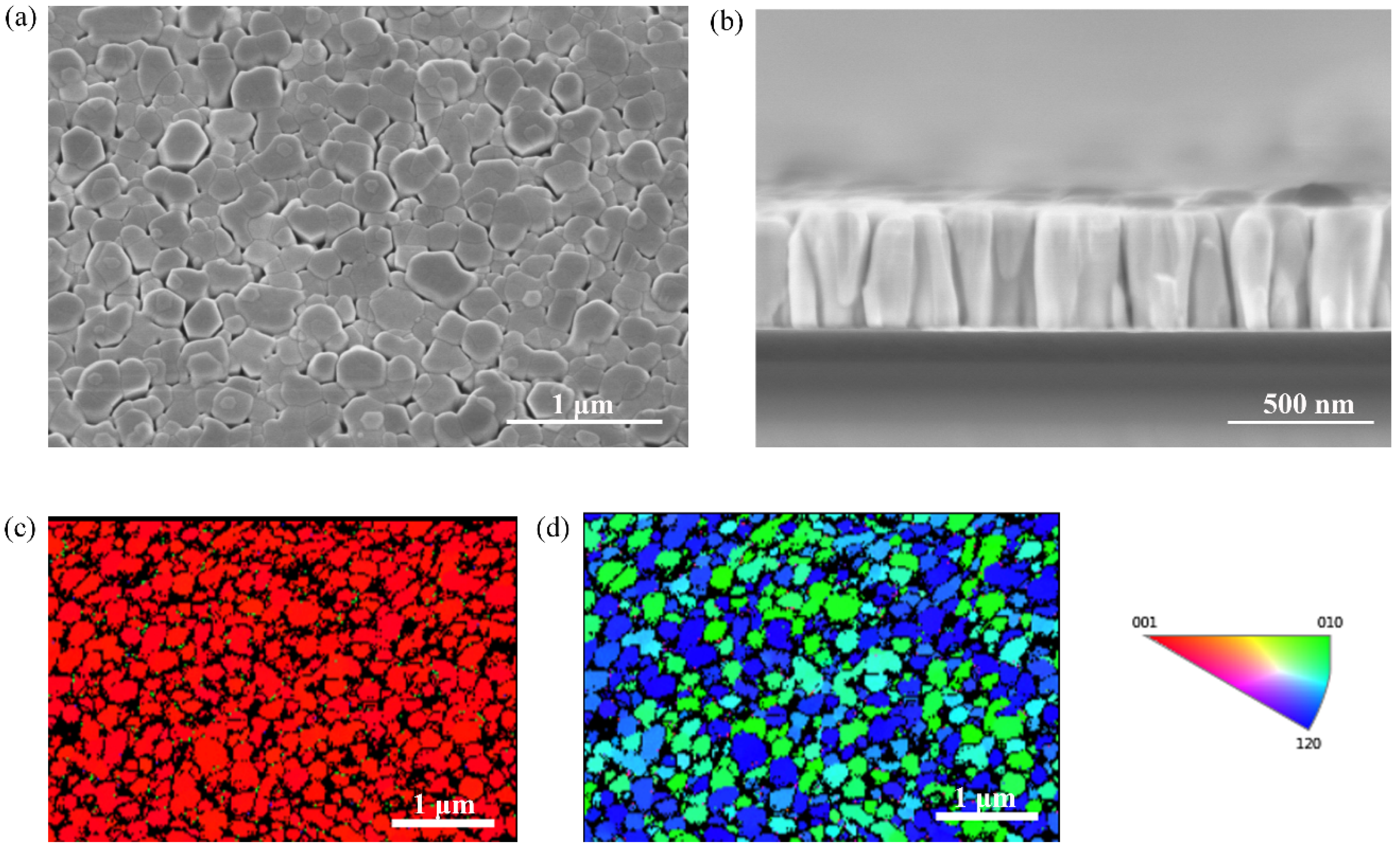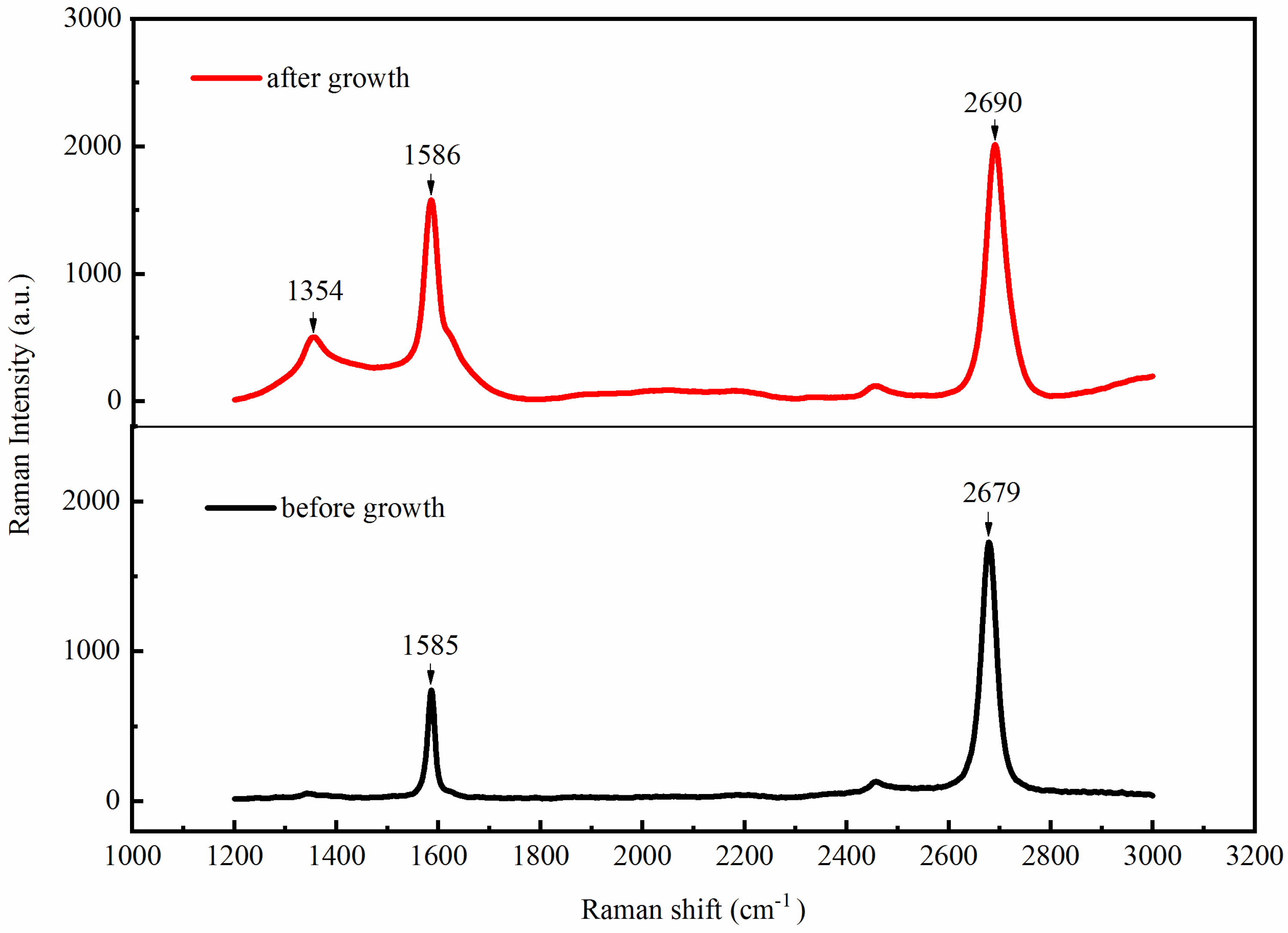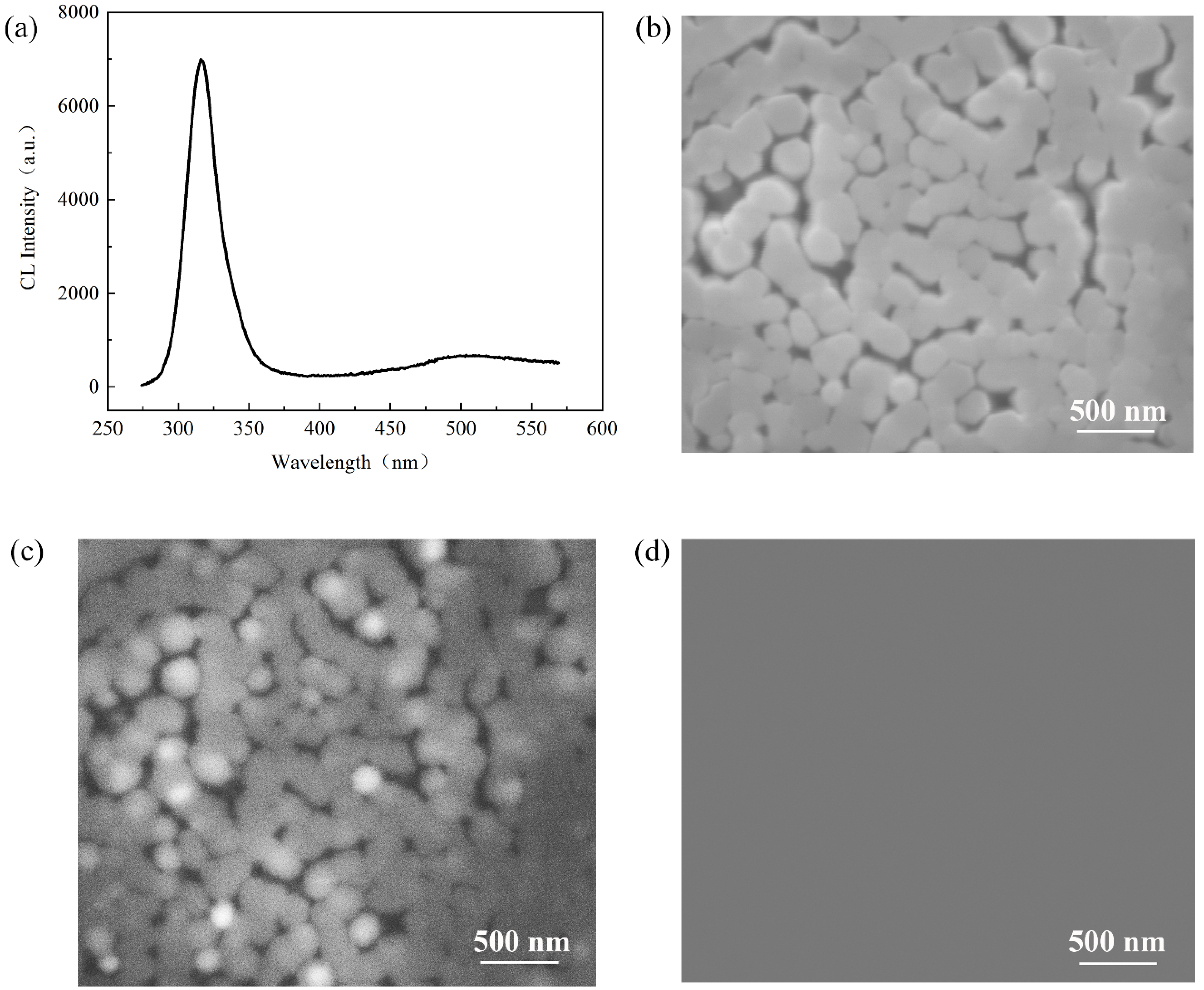Direct Growth of AlGaN Nanorod LEDs on Graphene-Covered Si
Abstract
1. Introduction
2. Materials and Methods
3. Results and Discussion
4. Conclusions
Author Contributions
Funding
Conflicts of Interest
References
- Zubia, D.; Hersee, S.D. Nanoheteroepitaxy: The Application of nanostructuring and substrate compliance to the heteroepitaxy of mismatched semiconductor materials. J. Appl. Phys. 1999, 85, 6492–6496. [Google Scholar] [CrossRef]
- Li, S.; Waag, A. GaN-based nanorods for solid state lighting. J. Appl. Phys. 2012, 111, 5. [Google Scholar] [CrossRef]
- Waag, A.; Wang, X.; Fündling, S.; Ledig, J.; Erenburg, M.; Neumann, R.; Al Suleiman, M.; Merzsch, S.; Wei, J.; Li, S.; et al. The nanorod approach: GaN nanoleds for solid state lighting. Phys. Status Solidi C 2011, 8, 2296–2301. [Google Scholar] [CrossRef]
- Djavid, M.; Mi, Z. Enhancing the light extraction efficiency of AlGaN deep ultraviolet light emitting diodes by using nanowire structures. Appl. Phys. Lett. 2016, 108, 051102. [Google Scholar] [CrossRef]
- Coulon, P.M.; Kusch, G.; Le Boulbar, E.D.; Chausse, P.; Bryce, C.; Martin, R.W.; Shields, P.A. Hybrid top-down/bottom-up fabrication of regular arrays of AlN nanorods for deep-UV core-shell leds. Phys. Status Solidi B 2018, 255, 1700445. [Google Scholar] [CrossRef]
- Coulon, P.M.; Kusch, G.; Martin, R.W.; Shields, P.A. Deep UV emission from highly ordered AlGaN/AlN core-shell nanorods. ACS Appl. Mater. Interfaces 2018, 10, 33441–33449. [Google Scholar] [CrossRef] [PubMed]
- Zhuang, Z.; Guo, X.; Zhang, G.; Liu, B.; Zhang, R.; Zhi, T.; Tao, T.; Ge, H.; Ren, F.; Xie, Z.; et al. Large-scale fabrication and luminescence properties of GaN nanostructures by a soft UV-curing nanoimprint lithography. Nanotechnology 2013, 24, 405303. [Google Scholar] [CrossRef] [PubMed]
- Wu, S.; Wang, L.; Yi, X.; Liu, Z.; Wei, T.; Yuan, G.; Wang, J.; Li, J. Influence of lateral growth on the optical properties of GaN nanowires grown by hydride vapor phase epitaxy. J. Appl. Phys. 2017, 122, 205302. [Google Scholar] [CrossRef]
- Wu, S.; Wang, L.; Yi, X.; Liu, Z.; Yan, J.; Yuan, G.; Wei, T.; Wang, J.; Li, J. Crystallographic orientation control and optical properties of GaN nanowires. RSC Adv. 2018, 8, 2181–2187. [Google Scholar] [CrossRef]
- Li, Y.; Zhao, Y.; Wei, T.; Liu, Z.; Duan, R.; Wang, Y.; Zhang, X.; Wu, Q.; Yan, J.; Yi, X.; et al. Van Der Waals epitaxy of GaN-based light emitting diodes on wet-transferred multilayer graphene film. Jpn. J. Appl. Phys. 2017, 56, 085506. [Google Scholar] [CrossRef]
- Mazid Munshi, A.; Weman, H. Advances in semiconductor nanowire growth on graphene. Phys. Status Solidi Rapid Res. Lett. 2013, 7, 713–726. [Google Scholar] [CrossRef]
- Liu, X.; Wang, F.; Wu, H.; Wang, W. Strengthening metal nanolaminates under shock compression through dual effect of strong and weak graphene interface. Appl. Phys. Lett. 2014, 104, 231901. [Google Scholar] [CrossRef]
- Kumaresan, V.; Largeau, L.; Madouri, A.; Glas, F.; Zhang, H.; Oehler, F.; Cavanna, A.; Babichev, A.; Travers, L.; Gogneau, N.; et al. Epitaxy of GaN nanowires on graphene. Nano Lett. 2016, 16, 4895–4902. [Google Scholar] [CrossRef] [PubMed]
- Chung, K.; Yoo, H.; Hyun, J.K.; Oh, H.; Tchoe, Y.; Lee, K.; Baek, H.; Kim, M.; Yi, G.C. Flexible GaN light emitting diodes using GaN microdisks epitaxial laterally overgrown on graphene dots. Adv. Mater. 2016, 28, 7688–7694. [Google Scholar] [CrossRef] [PubMed]
- Heilmann, M.; Munshi, A.M.; Sarau, G.; Gobelt, M.; Tessarek, C.; Fauske, V.T.; van Helvoort, A.T.; Yang, J.; Latzel, M.; Hoffmann, B.; et al. Vertically oriented growth of GaN nanorods on Si using graphene as an atomically thin buffer layer. Nano Lett. 2016, 16, 3524–3532. [Google Scholar] [CrossRef] [PubMed]
- Zeng, Q.; Chen, Z.; Zhao, Y.; Wei, T.; Chen, X.; Zhang, Y.; Yuan, G.; Li, J. Graphene-assisted growth of high-quality AlN by metalorganic chemical vapor deposition. Jpn. J. Appl. Phys. 2016, 55, 085501. [Google Scholar] [CrossRef]
- Qi, Y.; Wang, Y.; Pang, Z.; Dou, Z.; Wei, T.; Gao, P.; Zhang, S.; Xu, X.; Chang, Z.; Deng, B.; et al. Fast Growth of strain-free AlN on graphene-buffered sapphire. J. Am. Chem. Soc. 2018, 140, 11935–11941. [Google Scholar] [CrossRef] [PubMed]
- Gupta, P.; Rahman, A.A.; Hatui, N.; Gokhale, M.R.; Deshmukh, M.M.; Bhattacharya, A. MOVPE growth of semipolar III-nitride semiconductors on CVD graphene. J. Cryst. Growth 2013, 372, 105–108. [Google Scholar] [CrossRef]
- Lin, Y.T.; Yeh, T.W.; Dapkus, P.D. Mechanism of selective area growth of GaN nanorods by pulsed mode metalorganic chemical vapor deposition. Nanotechnology 2012, 23, 465601. [Google Scholar] [CrossRef] [PubMed]
- Lin, Y.T.; Yeh, T.W.; Nakajima, Y.; Dapkus, P.D. Catalyst-free GaN nanorods synthesized by selective area growth. Adv. Funct. Mater. 2014, 24, 3162–3171. [Google Scholar] [CrossRef]
- Journot, T.; Bouchiat, V.; Gayral, B.; Dijon, J.; Hyot, B. Self-assembled UV photodetector made by direct epitaxial GaN growth on graphene. ACS Appl. Mater. Interfaces 2018, 10, 18857–18862. [Google Scholar] [CrossRef] [PubMed]
- Calizo, I.; Bejenari, I.; Rahman, M.; Liu, G.; Balandin, A.A. Ultraviolet Raman microscopy of single and multilayer graphene. J. Appl. Phys. 2009, 106, 043509. [Google Scholar] [CrossRef]
- Sarau, G.; Lahiri, B.; Banzer, P.; Gupta, P.; Bhattacharya, A.; Vollmer, F.; Christiansen, S. Enhanced Raman scattering of graphene using arrays of split ring resonators. Adv. Opt. Mater. 2013, 1, 151–157. [Google Scholar] [CrossRef]
- Zafar, Z.; Ni, Z.H.; Wu, X.; Shi, Z.X.; Nan, H.Y.; Bai, J.; Sun, L.T. Evolution of Raman spectra in nitrogen doped graphene. Carbon 2013, 61, 57–62. [Google Scholar] [CrossRef]
- Chae, S.J.; Kim, Y.H.; Seo, T.H.; Duong, D.L.; Lee, S.M.; Park, M.H.; Kim, E.S.; Bae, J.J.; Lee, S.Y.; Jeong, H.; et al. Direct growth of etch pit-free GaN crystals on few-layer graphene. RSC Adv. 2015, 5, 1343–1349. [Google Scholar] [CrossRef]
- Reshchikov, M.A.; Morkoç, H. Luminescence properties of defects in GaN. J. Appl. Phys. 2005, 97, 5–19. [Google Scholar] [CrossRef]
- Watanabe, S.; Yamada, N.; Nagashima, M.; Ueki, Y.; Sasaki, C.; Yamada, Y.; Taguchi, T.; Tadatomo, K.; Okagawa, H.; Kudo, H. Internal quantum efficiency of highly-efficient InxGa1−xN-based near-ultraviolet light emitting diodes. Appl. Phys. Lett. 2003, 83, 4906–4908. [Google Scholar] [CrossRef]
- Mickevičius, J.; Jurkevičius, J.; Kadys, A.; Tamulaitis, G.; Shur, M.; Shatalov, M.; Yang, J.; Gaska, R. Low-temperature redistribution of non-thermalized carriers and its effect on efficiency droop in AlGaN epilayers. J. Phys. D Appl. Phys. 2015, 48, 275105. [Google Scholar] [CrossRef]
- Choi, J.K.; Huh, J.H.; Kim, S.D.; Moon, D.; Yoon, D.; Joo, K.; Kwak, J.; Chu, J.H.; Kim, S.Y.; Park, K.; et al. One-step graphene coating of heteroepitaxial GaN films. Nanotechnology 2012, 23, 435603. [Google Scholar] [CrossRef] [PubMed]
- Liu, X.; Le, B.H.; Woo, S.Y.; Zhao, S.; Pofelski, A.; Botton, G.A.; Mi, Z. Selective area epitaxy of AlGaN nanowire arrays across nearly the entire compositional range for deep ultraviolet photonics. Opt. Express 2017, 25, 30494–30502. [Google Scholar] [CrossRef] [PubMed]






| Step | NH3 (sccm) | TMGa (sccm) | TMAl (sccm) | SiH4 (sccm) | Cp2Mg (sccm) |
|---|---|---|---|---|---|
| Nitridation | 1000 | / | / | / | / |
| n-AlGaN | 1000 | 17.5 | 30 | 500 | / |
| nucleation islands | 15 | 35 | 290 | 500 | / |
| n-AlGaN nanorods | 15 | 35 | 250 | / | / |
| u-AlGaN MQWs | 15 | 35 | 290 | / | / |
| p-AlGaN | 15 | 30 | 250 | / | 150 |
© 2018 by the authors. Licensee MDPI, Basel, Switzerland. This article is an open access article distributed under the terms and conditions of the Creative Commons Attribution (CC BY) license (http://creativecommons.org/licenses/by/4.0/).
Share and Cite
Ren, F.; Yin, Y.; Wang, Y.; Liu, Z.; Liang, M.; Ou, H.; Ao, J.; Wei, T.; Yan, J.; Yuan, G.; et al. Direct Growth of AlGaN Nanorod LEDs on Graphene-Covered Si. Materials 2018, 11, 2372. https://doi.org/10.3390/ma11122372
Ren F, Yin Y, Wang Y, Liu Z, Liang M, Ou H, Ao J, Wei T, Yan J, Yuan G, et al. Direct Growth of AlGaN Nanorod LEDs on Graphene-Covered Si. Materials. 2018; 11(12):2372. https://doi.org/10.3390/ma11122372
Chicago/Turabian StyleRen, Fang, Yue Yin, Yunyu Wang, Zhiqiang Liu, Meng Liang, Haiyan Ou, Jinping Ao, Tongbo Wei, Jianchang Yan, Guodong Yuan, and et al. 2018. "Direct Growth of AlGaN Nanorod LEDs on Graphene-Covered Si" Materials 11, no. 12: 2372. https://doi.org/10.3390/ma11122372
APA StyleRen, F., Yin, Y., Wang, Y., Liu, Z., Liang, M., Ou, H., Ao, J., Wei, T., Yan, J., Yuan, G., Yi, X., Wang, J., Li, J., Dasa, D., & Weman, H. (2018). Direct Growth of AlGaN Nanorod LEDs on Graphene-Covered Si. Materials, 11(12), 2372. https://doi.org/10.3390/ma11122372





